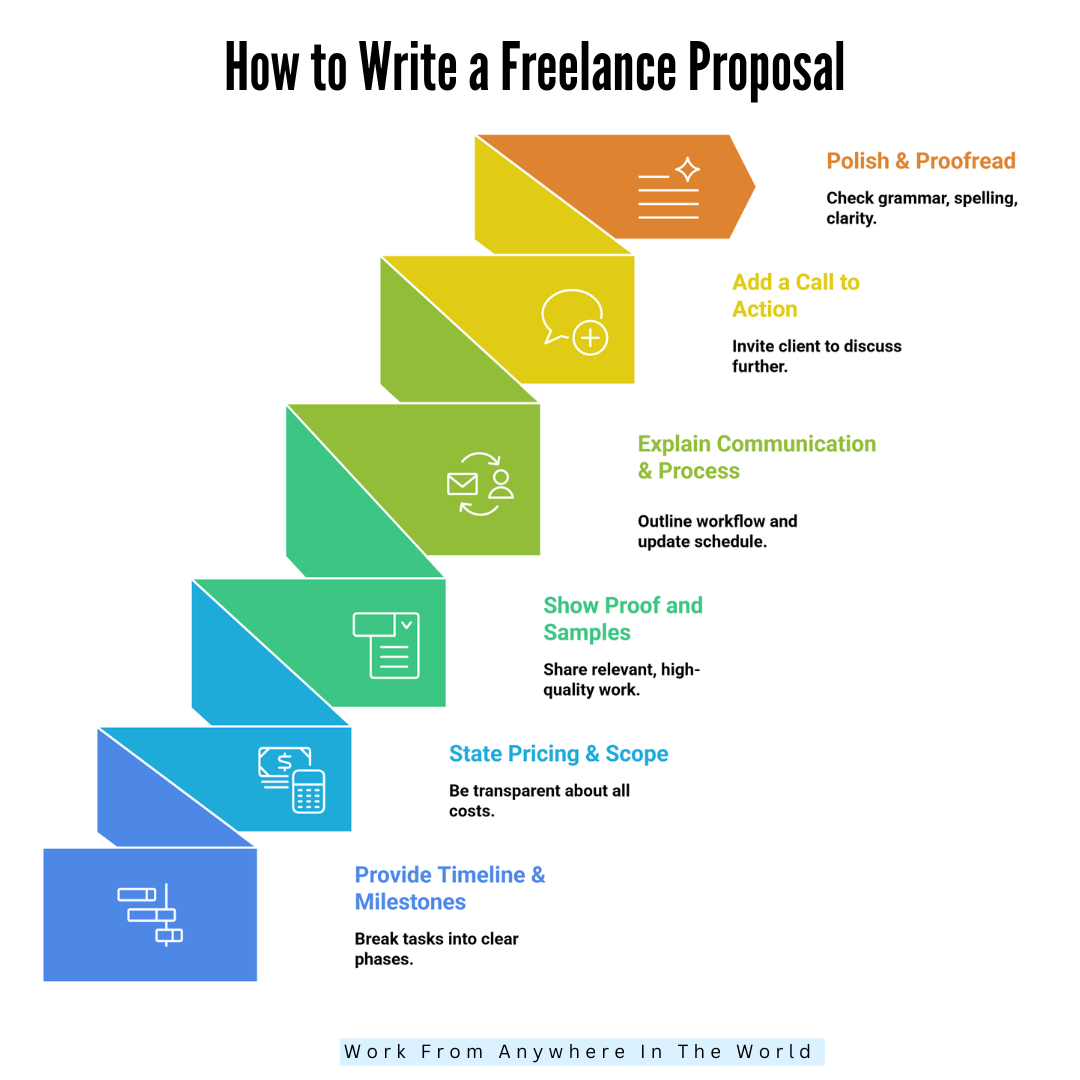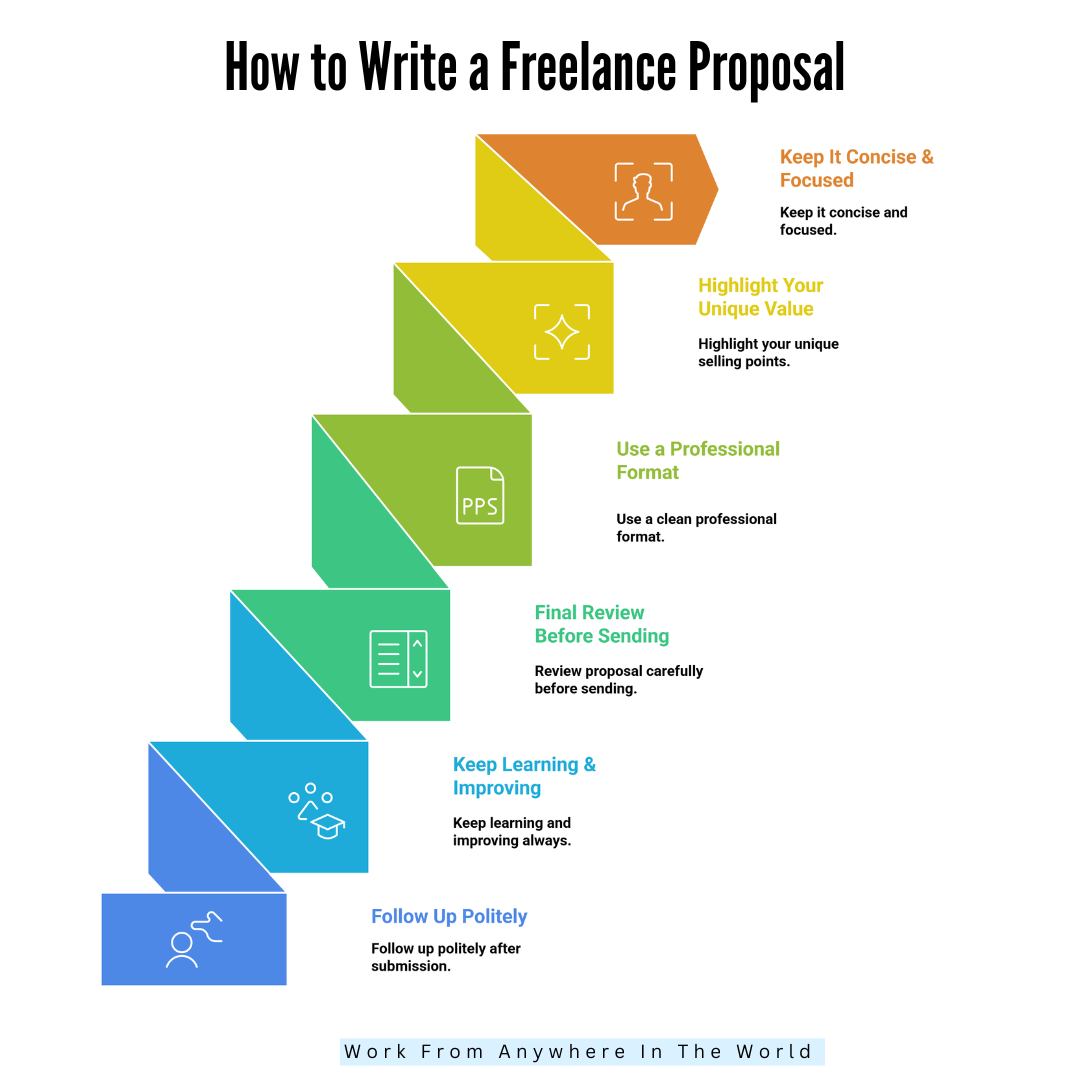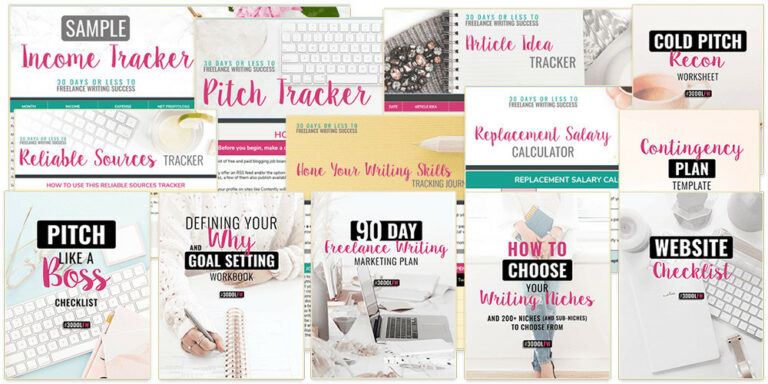How To Write A Freelance Proposal – A Complete Guide
Writing a freelance proposal can make or break your chances of landing a client. It’s your first impression, your pitch, and your opportunity to show you understand their needs.
A well-crafted proposal highlights your skills, builds trust, and clearly explains how you’ll solve the client’s problem.
In this guide, we’ll walk you through simple, practical steps to write proposals that grab attention, stand out from the crowd, and help you win more freelance projects.
With the help of this article, you will learn how to develop a freelance proposal that will attract clients and land you work.
What Is A Freelance Proposal?
A freelance proposal is a personalized document or message that freelancers send to potential clients to showcase their skills, understanding of the project, and ability to deliver results.
It acts as a bridge between a freelancer’s expertise and a client’s needs. Unlike a simple resume, a proposal is project-specific—it addresses the client’s goals, outlines your approach, and explains why you’re the ideal person for the job.
A strong freelance proposal highlights your understanding of the client’s problem, provides a clear plan of action, and demonstrates confidence through examples or past work.
It should sound conversational yet professional, focusing on how you can add value rather than just listing your qualifications. The best proposals are concise, relevant, and easy to read, helping clients quickly see your strengths.
In short, a freelance proposal is your marketing pitch—a well-written one can turn a potential opportunity into a lasting professional relationship by showing clients that you understand, care, and can deliver exactly what they need.
How To Write A Freelance Proposal
Step 1: Research The Client
Before writing a freelance proposal, start by researching the client. Read their job post carefully to understand what they need. Visit their website to learn about their brand, values, and target audience.
Check social media profiles to see how they engage with followers and communicate their message. Look for challenges or pain points they might be facing. This information helps you craft a proposal that speaks directly to their needs.
Thorough research shows professionalism, builds credibility, and makes your pitch more persuasive. Personalization begins with understanding the client fully.
Key Tips
- Read the job post carefully for the main requirements.
- Visit their website to understand the brand and values.
- Check social media for tone, style, and engagement.
- Identify challenges to address in your proposal.
Step 2: Understand The Project Scope
After researching the client, the next step is to understand the project scope. Carefully analyze the job description to know what deliverables are expected.
Clarify deadlines, project length, and any special requirements. Understanding the scope ensures your proposal is accurate and realistic.
Avoid assumptions about tasks or timelines. Knowing precisely what the client wants helps you outline a clear plan and prevents miscommunication later.
It also allows you to propose solutions confidently, showing that you’ve thought through the project thoroughly. A clear understanding builds trust and positions you as a reliable freelancer.
Key Tips
- List all deliverables mentioned in the job post.
- Note deadlines and important project milestones.
- Clarify any unclear instructions before writing the proposal.
- Understand requirements to provide realistic solutions.
Step 3: Personalize The Greeting
When writing a freelance proposal, start with a personalized greeting. Skip generic openers like “Dear Sir/Madam” or “To whom it may concern.”
If the client’s name is available, use it directly. If not, address their company or team, for example, “Hello [Company Name] Team.”
A personalized greeting immediately makes your proposal feel human and shows that you’ve paid attention. This small effort sets a friendly, professional tone for the entire proposal.
Clients notice these details, and it helps your message stand out among dozens of generic applications. First impressions matter, so start strong.
Key Tips
- Always use the client’s name if known.
- Address the company team if no name.
- Avoid generic greetings that seem impersonal.
- Keep the tone friendly, warm, and professional.
Step 4: Write An Attention-Grabbing Opening
The opening line of your freelance proposal is crucial. It decides whether the client keeps reading. Avoid generic statements like “I am a professional freelancer.” Instead, start with a confident, engaging line that shows you understand their problem.
For example, mention how your skills can solve their specific challenge or highlight relevant experience. Keep it conversational and focused on the client, not yourself.
A strong opening builds curiosity, establishes credibility, and sets the tone for the rest of your proposal. Remember, the first impression can make the difference between getting noticed and being ignored.
Key Tips
- Start with a confident, client-focused statement.
- Highlight relevant experience or skills immediately.
- Avoid generic phrases that sound robotic or common.
- Keep it short, clear, and engaging.
Step 5: Show You Understand The Client’s Needs
After a strong opening, demonstrate that you understand the client’s needs. Summarize their problem in your own words to show you’ve read the brief carefully. Mention their goals, pain points, or desired outcomes.
This reassures the client that you’re focused on their objectives, not just selling your services. Empathy and clarity here build trust and make your proposal stand out from generic submissions.
Avoid vague statements like “I can do this job.” Instead, speak directly to their challenges and explain why addressing them matters for their project’s success.
Understanding the client’s needs is a key step in learning how to write a freelance proposal that truly resonates and builds trust.
Key Tips
- Restate the client’s problem in clear words.
- Highlight their goals and desired outcomes.
- Show empathy to build client trust.
- Avoid vague statements about your abilities.
Step 6: Propose Your Solution
Once you’ve shown understanding, clearly explain how you’ll solve the client’s problem. Outline your approach step by step, keeping it simple and focused on results.
Avoid technical jargon that might confuse the client. Show them exactly what actions you’ll take and how it benefits their project.
This section demonstrates your expertise and reassures the client that you have a practical plan. Be confident but not boastful.
A clear, actionable solution helps the client visualize success and increases the likelihood they’ll choose you over others. Keep it concise and client-focused.
Key Tips
- Provide a detailed plan for resolving the issue.
- Focus on benefits and results for the client.
- Avoid confusing jargon or unnecessary technical terms.
- Keep it concise, clear, and actionable.

Step 7: Provide Timeline And Milestones
After presenting your solution, include a clear timeline and milestones. Break the project into phases and indicate when each part will be completed. This shows the client you are organized and realistic about deadlines.
A structured timeline sets expectations and reduces misunderstandings. It also demonstrates professionalism and reliability, reassuring the client that you can deliver on time.
Even a simple outline with significant steps and estimated completion dates is effective. Clear milestones help clients track progress and build confidence that their project is in capable hands.
Key Tips
- Break the project into clear, manageable phases.
- Include estimated completion dates for each milestone.
- Keep the timeline realistic and achievable.
- Show organization and professionalism through structured planning.
Step 8: State Pricing And Scope
Next, clearly state your pricing and project scope. Specify what’s included in your service, such as the number of revisions, deliverables, or hours. Be transparent to avoid confusion later.
If charging hourly, mention your rate; if fixed, provide the total cost. Explaining the scope alongside pricing helps clients understand the value they’re getting. Avoid vague statements like “reasonable price” — be specific.
Clarity on pricing and scope demonstrates professionalism, builds trust, and prevents disagreements. When clients know precisely what they’ll receive and at what cost, they feel confident moving forward with your proposal.
Key Tips
- Clearly define all services included in the project.
- Specify total cost or hourly rate upfront.
- Mention the number of revisions or deliverables included.
- Be transparent to build trust and avoid confusion.
Step 9: Show Proof And Relevant Samples
Clients want evidence that you can deliver results. Include proof of experience by sharing relevant samples or links to past projects. Highlight work similar to the client’s needs, emphasizing successful outcomes.
You can mention client names, metrics, or case studies if allowed. This builds credibility and reassures clients that you have the skills to complete their project effectively.
Avoid overloading with too many examples — focus on quality and relevance. Showing proof demonstrates confidence in your abilities and makes your proposal stand out from others who simply claim they can do the work.
Key Tips
- Include 1–3 relevant project samples or portfolio links.
- Highlight results or outcomes from previous projects.
- Focus on quality and relevance over quantity.
- Mention metrics or client names when appropriate.
Wealthy Affiliate – Mini Review (2025)
If you’ve ever thought about turning your blog, passion, or niche into an online business,
Wealthy Affiliate (WA) is one of the most beginner-friendly platforms I’ve used.
It combines step-by-step training, website hosting, SEO research tools,
and an active community all in one place.
What I like most: you can start free (no credit card needed),
explore lessons, test the tools, and connect with other entrepreneurs
before upgrading. WA isn’t a “get rich quick” scheme — it’s a platform where success comes
from consistent effort and applying what you learn.
Step 10: Explain Communication And Process
Clearly explaining your workflow is an essential aspect of how to write a freelance proposal that instills confidence and demonstrates professionalism.
Explain the tools or methods you’ll use, such as email, project management apps, or video calls. Mention how often you’ll provide updates and how revisions will be handled.
Clear communication shows professionalism and reduces client uncertainty. Clients feel more confident when they know what to expect and how they’ll be involved.
Keeping this section concise but informative demonstrates organization, reliability, and a client-focused approach. A well-defined process ensures smoother collaboration and builds trust even before the project begins.
Key Tips
- Specify communication channels you’ll use for updates.
- Mention how often clients will receive progress reports.
- Explain your revision or feedback process clearly.
- Keep instructions simple and easy for clients to follow.
Step 11: Add A Call To Action
End your freelance proposal with a clear call to action (CTA). Invite the client to take the next step, such as scheduling a call, asking questions, or confirming the project. Keep it friendly and confident, without sounding pushy.
A strong CTA encourages engagement and moves the client closer to hiring you. Phrases like “Let’s discuss your project further” or “I’d love to hear your thoughts” work well.
Ending with a CTA gives your proposal direction and shows enthusiasm. It leaves the client with a clear idea of what to do next, increasing your chances of getting hired.
Key Tips
- Invite the client to schedule a call or chat.
- Keep your call to action friendly and professional.
- Encourage questions or clarifications from the client.
- End with confidence and enthusiasm to engage them.
Step 12: Polish And Proofread
Before sending your proposal, take time to polish and proofread it. Check for grammar, spelling, and punctuation errors. Ensure sentences are clear, concise, and easy to read.
Avoid jargon or complex words that may confuse the client. A clean, error-free proposal reflects professionalism and attention to detail. Reading it aloud can help spot awkward phrasing or unclear points.
A well-polished proposal increases credibility and makes a stronger impression. Remember, even a great idea can be overlooked if the proposal looks sloppy or rushed.
Key Tips
- Check grammar, spelling, and punctuation carefully.
- For clarity, use brief paragraphs and bullet points.
- Avoid technical jargon unless necessary for the client.
- Read aloud to spot awkward sentences or errors.

Step 13: Follow Up Politely
If you haven’t heard back after submitting your proposal, it’s essential to follow up politely. Wait 3–5 days before sending a short, friendly message. Express continued interest in the project and offer to answer any questions.
Keep your tone professional and respectful, avoiding pressure or impatience. A well-timed follow-up shows dedication, professionalism, and enthusiasm without being pushy.
Many clients appreciate reminders, as they can get busy or overlook messages. Following up can often turn a pending proposal into a confirmed project, giving you a better chance of winning the client.
Key Tips
- Wait a few days before sending a follow-up message.
- Keep your tone friendly, polite, and professional.
- Offer to respond to inquiries or give further information.
- Avoid being pushy; show genuine interest instead.
Step 14: Keep Learning And Improving
Every proposal you write is a chance to learn and improve. Track which proposals succeed and which don’t. Analyze patterns in language, structure, or client responses to understand what works best. Ask for feedback when possible and refine your approach.
Experiment with different openings, formats, and styles to see what resonates with clients. Continuous improvement increases your success rate and helps you craft proposals faster over time.
Treat each proposal as practice to sharpen your skills, build confidence, and become more persuasive. Freelancing is a learning process, and consistent refinement leads to long-term success.
Key Tips
- Track outcomes to identify successful proposal patterns.
- Analyze client responses to refine your approach.
- Experiment with openings, formats, and writing styles.
- Treat each proposal as practice for improvement.
Step 15: Final Review Before Sending
Learning how to produce a clean, professional, and error-free freelance proposal requires doing a thorough final review.
Ensure all client details are correct, links work, and your tone is consistent throughout. Confirm that your solution, timeline, and pricing are clearly stated.
Check that the proposal is concise, readable, and free of errors. This last review helps you catch small mistakes that could undermine professionalism.
A thorough final check demonstrates attention to detail and commitment to quality. Sending a polished, complete proposal increases your chances of impressing the client and securing the project.
Key Tips
- Verify all client names and project details are correct.
- Test all links and attachments for functionality.
- Ensure pricing, scope, and timeline are transparent.
- Read the proposal one final time for errors.
Step 16: Use A Professional Format
A professional format makes your proposal easy to read and visually appealing. Make use of bullet points, brief paragraphs, and distinct headings. Include your name, contact information, and a project title at the top.
Avoid cluttered text or long walls of words. A clean layout shows organization and professionalism, making it easier for the client to navigate your proposal.
Simple formatting with consistent fonts, spacing, and alignment improves readability. When clients can quickly understand your offer, they’re more likely to engage positively. Presentation is as important as content when it comes to freelance proposals.
Key Tips
- Use headings and subheadings for a clear structure.
- Keep paragraphs short and readable.
- Include contact information at the top.
- Maintain consistent fonts, spacing, and alignment.
Step 17: Highlight Your Unique Value
Stand out by emphasizing your unique value. Explain what makes you different from other freelancers. Maybe it’s specialized experience, faster delivery, or creative problem-solving skills.
Emphasize the advantages the consumer will experience as a result of selecting you. Avoid generic statements; be specific and confident.
Showing your unique value helps the client understand why hiring you is the best decision. When clients see how you can solve their problem better than others, your proposal becomes more persuasive.
Clearly communicating your strengths increases your chances of winning the project and building a long-term professional relationship.
Key Tips
- Determine what makes you unique among freelancers.
- Highlight the benefits the client will receive.
- Be specific and avoid vague statements.
- Show confidence without sounding boastful.
Step 18: Keep It Concise And Focused
A strong freelance proposal is concise and focused. Avoid unnecessary details or long-winded explanations. Concise and targeted freelance proposal writing makes your submission stand out and keeps the client interested.
For ease of reading, utilize bullet points and brief words. Clients often review many proposals, so clarity and brevity increase your chances of standing out. Focus on outcomes, your approach, and proof of experience.
Keeping the proposal sharp and to the point shows respect for the client’s time and demonstrates professionalism, making it more likely they’ll read your proposal thoroughly and respond positively.
Key Tips
- Stick to relevant details only.
- Use short sentences for clarity.
- Utilize bullet points for readability.
- Focus on results and client benefits.

Conclusion
Mastering how to write a freelance proposal ensures your submissions are precise, personalized, and more likely to win projects consistently. Remember to keep proposals concise, client-focused, and well-formatted.
With practice and attention to detail, you can craft proposals that stand out, win projects consistently, and help build a successful, long-term freelance career. Confidence and clarity make all the difference.
I trust you enjoyed this article on How To Write A Freelance Proposal – A Complete Guide. Please stay tuned for more insightful blogs on affiliate marketing, online business, and working from anywhere in the world.
Take care!
— JeannetteZ
💬 Your Opinion Is Important To Me
Do you have thoughts, ideas, or questions? I’d love to hear from you. Please leave your comments below or email me directly at Jeannette@WorkFromAnywhereInTheWorld.com.
📚 More Work From Anywhere Reads
🚀 Ready to Build a Business You Can Run from Home
or from Anywhere in the World?
Imagine creating income on your terms — from home, a cozy café, or wherever life takes you.
With the right tools, training, and community support, it’s entirely possible.
Start your own online business for free — no credit card needed.
Disclosure
This post may contain affiliate links. As an Amazon Associate and participant in other affiliate programs, I earn from qualifying purchases at no extra cost to you. Please read my full affiliate disclosure.







